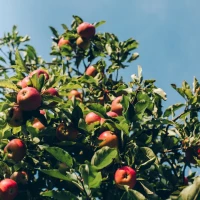When it comes to summertime bliss, few things can beat the sweet, juicy burst of flavor from a perfectly ripe cantaloupe. Whether you’re picnicking in the park or looking for a refreshing snack, choosing a ripe cantaloupe is an art form that can elevate your fruit experience from mediocre to extraordinary. But how can you tell if a cantaloupe is ripe? This comprehensive guide will shed light on the subtle yet distinct cues to help you pick the best of the bunch, ensuring that your palate is graced with the peak of perfection.
The Art of Selecting a Ripe Cantaloupe
Cantaloupe selection can be akin to uncovering a hidden treasure. With a keen eye and a few tactful techniques, you can decipher the condition of these melons from the outside. Let’s delve into the key characteristics you should be looking for.
Using the Senses: Sight, Smell, and Touch
Appearance is Key
Evaluating the external appearance of a cantaloupe can provide significant insights into its ripeness. Here’s what to look for:
- Netting pattern: Ripe cantaloupes have a prominent, raised webbed surface (also known as netting). It should be beige to light tan in color, and not green, which indicates immaturity.
- Background color: The part of the melon not covered by netting should have transformed from green to a warm, yellow color.
- Stem end: A ripe cantaloupe will have a smooth, well-rounded indentation where the stem was attached, indicating that it detached easily when ripe. A stem attached or a rough stem scar indicates immaturity.
The Aroma Tells All
The aroma of a cantaloupe is one of the most telling signs of its ripeness. A fruit that exudes a sweet, musky scent from the blossom end (opposite the stem) is often mature and ready to eat. If the smell is overwhelmingly strong or alcoholic, it may be past its prime.
The Feel of Perfection
A gentle press of the thumb near the blossom end should yield just slightly under pressure if the cantaloupe is ripe. The skin should feel slightly waxy, not too smooth or too rough. The weight is another indicator; a ripe cantaloupe should feel heavy for its size, suggesting a high water content and juiciness.
Sound Advice: The Tap Test
Gently tapping the cantaloupe with your hand and listening to the sound it produces can offer further clues. A ripe, mature cantaloupe typically produces a dull, deep sound, while an immature or overly ripe one sounds hollow or higher-pitched, respectively.
Inside Scoop: Examining the Cantaloupe’s Interior
Even with all exterior inspections, the true test of ripeness is often revealed only upon cutting the melon open. The interior should showcase the quintessential cantaloupe hue - a vibrant orange. It should be:
- Uniformly colored, without green lines
- Moist but not soggy
- Firm but not hard, with a slightly buttery texture when eaten
The seeds at the center should come out easily if scooped, suggesting the flesh has softened adequately.
The Sugar Rush: Brix Test
Professionals sometimes use a tool called a refractometer to measure the sugar content of a cantaloupe, known as its Brix level. Home cooks won’t typically have this tool, but knowing that sweetness correlates with ripeness can encourage you to taste test whenever possible.
Storing Your Cantaloupe Right for Ripeness
Even after you’ve taken a ripe cantaloupe home, how you store it can affect its taste and longevity. Follow these tips to keep your cantaloupe at just the right level of ripeness.
Before Cutting
- Store uncut cantaloupes on your countertop at room temperature to enhance ripening.
- A partially ripe cantaloupe can be left in a paper bag to expedite the process.
- Avoid refrigeration for unripe cantaloupes, as it can hinder the ripeness and lead to a less flavorful experience.
After Cutting
- Refrigeration is a must for cut cantaloupe. Wrap it tightly or store it in an airtight container.
- Consume cut cantaloupe within three to five days for the best quality.
Nutritional Nuggets: Cantaloupe Benefits
Aside from their succulent taste, cantaloupes are storehouses of nutrition, offering an array of benefits that include:
- Rich sources of Vitamin A and C, essential for eye health and immunity.
- Hydration heroes due to their high water content.
- Containing fiber, which aids in digestion.
Knowing that such a delicious treat also packs a nutritional punch can make the experience even more satisfying.
Common Missteps in Choosing Ripe Cantaloupes
Avoiding common pitfalls can save you from a disappointing cantaloupe encounter. Here are the mistakes to bypass:
- Picking a melon with a greenish hue or an attached stem, which are signs of under-ripeness.
- Ignoring the weight and feel of the cantaloupe; it should be substantial and yield slightly under pressure.
- Disregarding the importance of aroma; a ripe cantaloupe will have a distinct, enticing smell.
FAQs: Ripe Cantaloupe Queries
How long does it take for a cantaloupe to ripen on the countertop?
A cantaloupe can ripen within a few days on the countertop, but this is dependent on how under-ripe it was when purchased.
Can you ripen a cantaloupe in the refrigerator?
No, chilling can slow down or cease the ripening process. Keep it at room temperature to ripen properly.
What does a ripe cantaloupe look like on the inside?
The interior should exhibit a uniform, creamy orange color. The texture should be firm yet yielding, and it should be moist without excess liquid.
Why is my cantaloupe tasteless?
A lack of flavor often results from picking an under-ripe cantaloupe, poor fruit genetics, or less-than-ideal growing conditions affecting sugar content.
Concluding the Cantaloupe Quest
Embarking on the quest for the perfectly ripe cantaloupe can be both exciting and daunting, but armed with these expert tips, your next selection is sure to be a sweet success. From the distinct netting and warm hues to the weighty feel and aromatic hints, each cue plays a pivotal role in determining ripeness. Enjoying this melon at its peak not only grants you a divine taste but also showers you with beneficial nutrients. So the next time you find yourself wandering the produce aisle, remember these cues to uncover the secret signs of perfect ripeness. Your taste buds will thank you!
Indulging in the succulent sweetness of a ripe cantaloupe is a summer rite of passage, and now, with the secrets of selecting the perfect melon revealed, you’re poised to make every bite count. Whether enjoyed in fruit salads, smoothies, or simply on its own, the cantaloupe remains a beloved treasure amongst fruit connoisseurs. So go ahead, let the adventure for ripeness begin and transform the ordinary into a delectable discovery of nature’s bounty.










